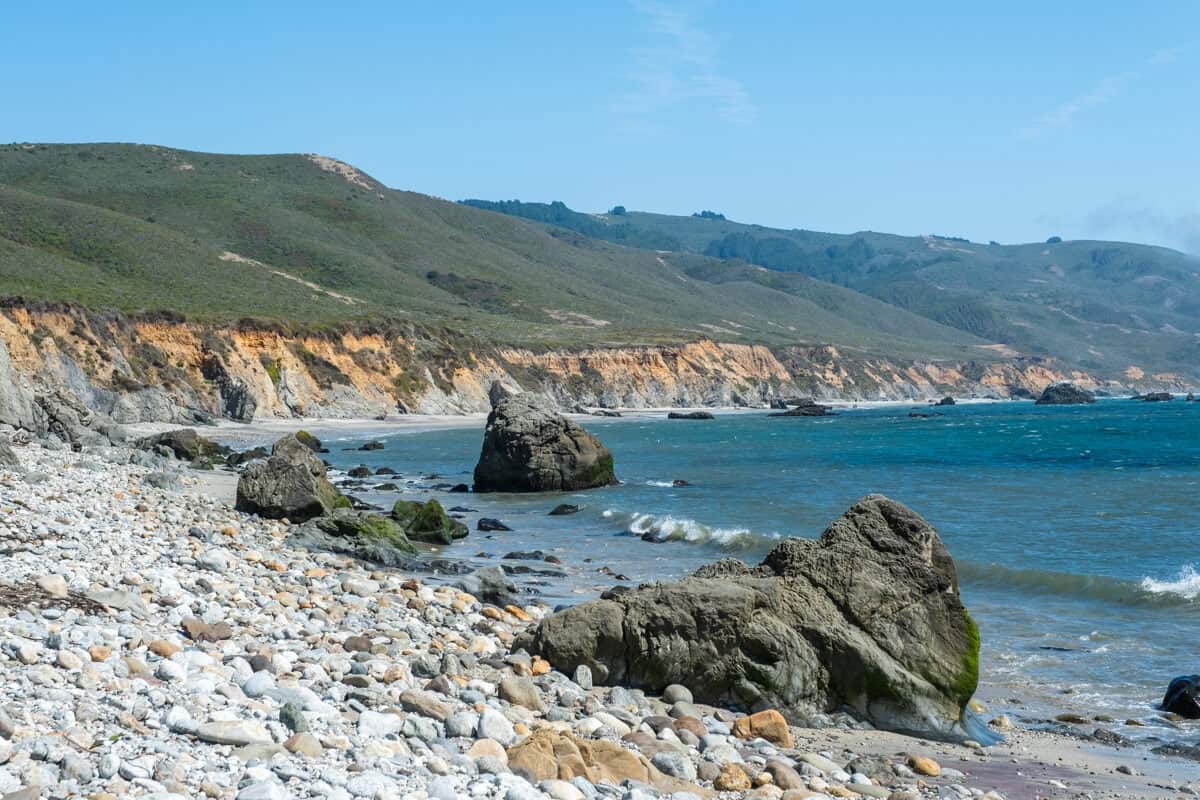Ultimate Big Sur Winter Guide: Weather And Best Things To Do
Is it worth going to Big Sur in winter? Perhaps you feel unsure about the weather, or are trying to find out if there’s anything worth doing there between December and March.
Big Sur is one of the most beautiful places along the Pacific Coast Highway, and I’ve visited 3 times within the first year of us moving to California. I even helped my relative get engaged there!
Although conventional advice is for visitors to avoid Big Sur during the winter months, I’ve had a lot of fun visiting during late winter. You might encounter road closures, limited amenities, and rainy days, but I have ideas on how you can make the most of your winter trip.
Whether you’re looking to spend the holidays in Big Sur, or you’re considering whether to visit on a day trip from Carmel or Monterey, this winter travel guide is for you. It covers the weather, best things to do, where to stay and safety tips for driving there.
This article uses affiliate links where I make a small commission if you make a purchase through my links, at no additional cost to you. As an Amazon Associate I earn from qualifying purchases.
Weather
The two main things you need to know about the winter weather in Big Sur are temperature and rainfall.
Temperature
During winter, Big Sur experiences mild to cold temperatures. Average daytime temperatures range from 50°F to 60°F (10°C to 15°C), while nighttime temperatures can drop to around 40°F (4°C).
The cooler weather can be refreshing, especially if you’re coming from a warmer climate. It’s essential to dress in layers to adjust to the changing temperatures throughout the day. In addition, the coastal winds can make it feel colder than the temperature suggests.
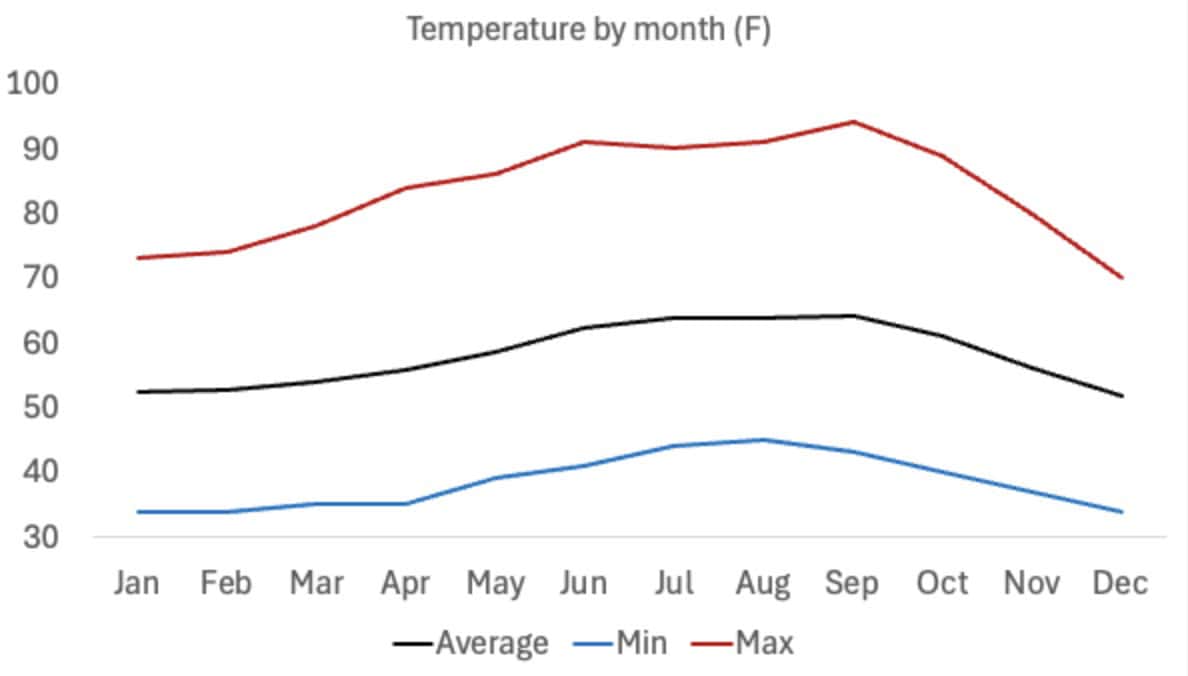
Coastal vs inland weather differences
Big Sur’s coastal areas tend to be milder and more humid, while inland regions can be colder, especially at higher elevations. Coastal areas are more likely to experience fog and wind, while inland areas can have more significant temperature fluctuations.
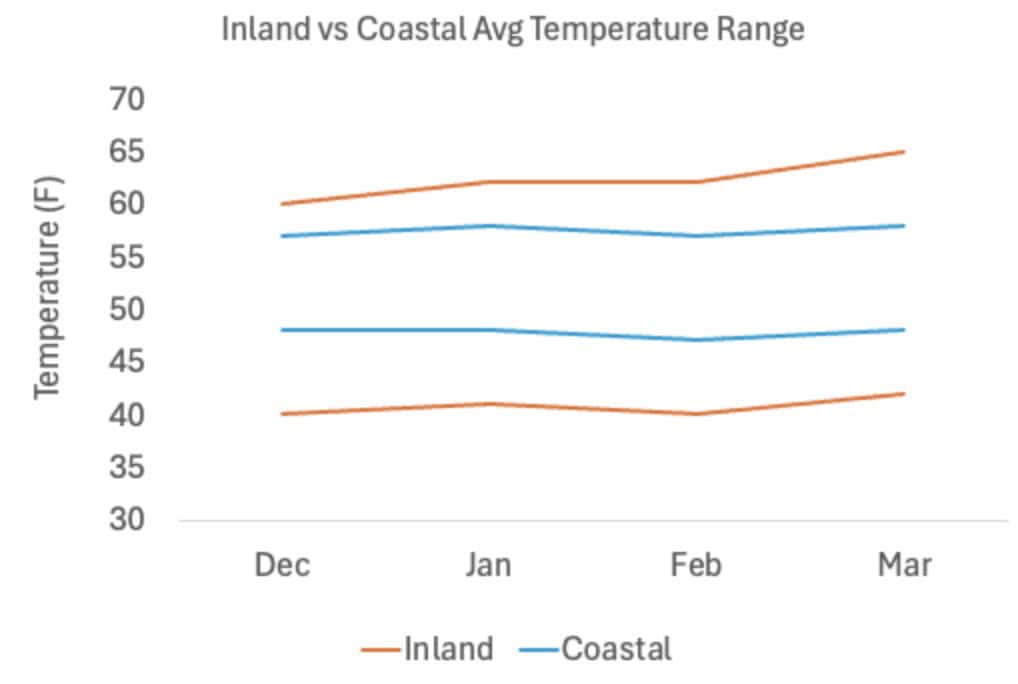
Rainfall
Winter is the rainy season in Big Sur with an average of around 9 inches of precipitation per month. Rainfall can vary significantly, with some years experiencing heavy rains that can cause road closures and landslides.
December is the wettest month in general, averaging 13 inches of rain over the past 5 years. The rain can create lush greenery and spectacular waterfalls, but it’s crucial to be prepared for wet conditions.
Here’s a look at the rainfall data between 2019 to 2023. Notably, December 2022 had 19 inches of rainfall and that when major road damage happened at Paul’s Slide.
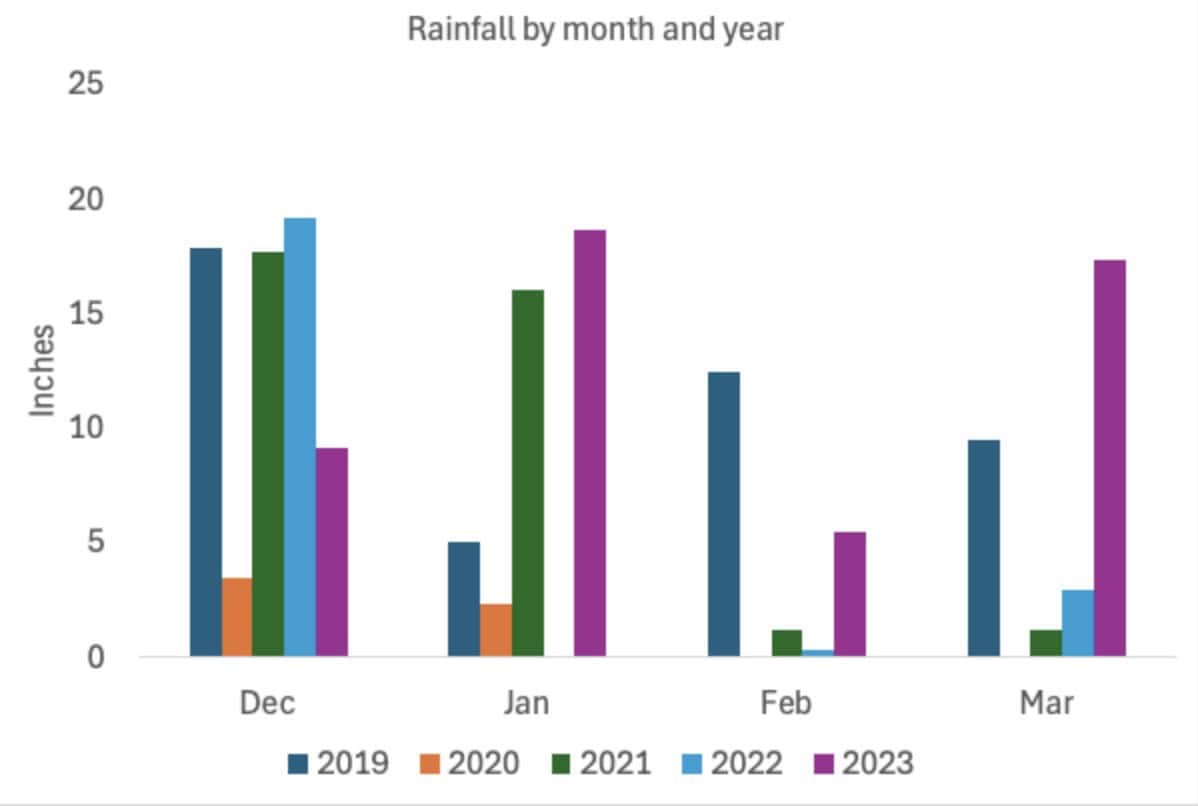
Sunrise and sunset
Winter days are shorter, with sunrise around 7:00 AM and sunset around 5:00 PM. The shorter daylight hours mean you’ll need to plan your activities to maximize the available daylight.
However, winter sunsets are often stunning, with vibrant colors reflecting off the ocean and cliffs. My first time seeing McWay Falls was during golden hour in late winter, and I’ve never seen it better since then.
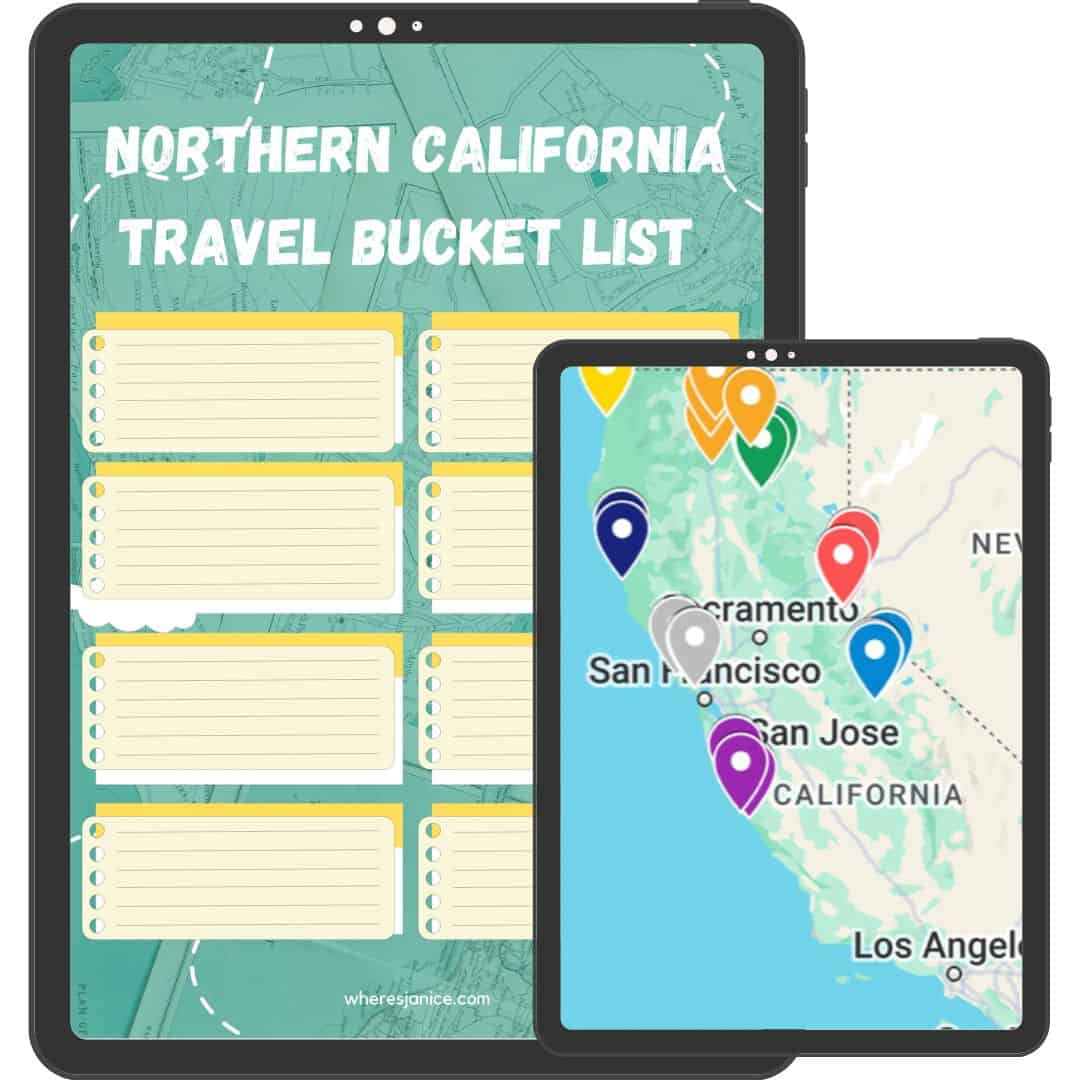
Best Things To Do in Big Sur during Winter
Big Sur’s off-peak season is during winter, where you’ll have much fewer crowds. That way, you’ll get all these amazing spots and activities to yourself.
1. Whale watching 🐋
During the winter, California gray whales migrate south to warmer breeding grounds, often coming close to Big Sur’s shores. This migration provides excellent whale-watching opportunities, especially from December to April.
Prime viewing spots include Point Lobos State Natural Reserve, Garrapata State Park, and the overlooks along Highway 1. Bring binoculars if you want to have a closer look.
2. Hiking 🚶♀️
It’s much easier to get parking and access popular hiking trails when it’s less crowded. In addition, the cooler weather makes for comfortable hiking conditions.
McWay Falls
McWay Falls is one of Big Sur’s most iconic landmarks. This 80-foot waterfall cascades directly onto the beach, and is one of 3 such waterfalls in California. The short hike to the overlook is accessible year-round via an easy and mostly flat trail. In addition, you’ll enjoy stunning views of the surrounding coastline.
Partington Cove Trail
The Partington Cove Trail is a moderate hike that takes you through a tunnel to a secluded cove with vibrant turquoise water. It starts with a steep descend down into the canyon, offering beautiful coastal views that make you forget that you need to climb up again at the end. You’ll also hear the sound of rushing water from Partington Creek, which could be fuller during winter.
Garrapata State Park
Garrapata State Park offers some of the most scenic and accessible hiking trails in Big Sur. Two notable trails within the park are the Garrapata Bluff Trail and the Soberanes Point Trail. These trails provide stunning coastal views and are relatively short, making them perfect for a quick hike. In winter, the trails are less crowded, allowing you to enjoy the serenity of the surroundings.
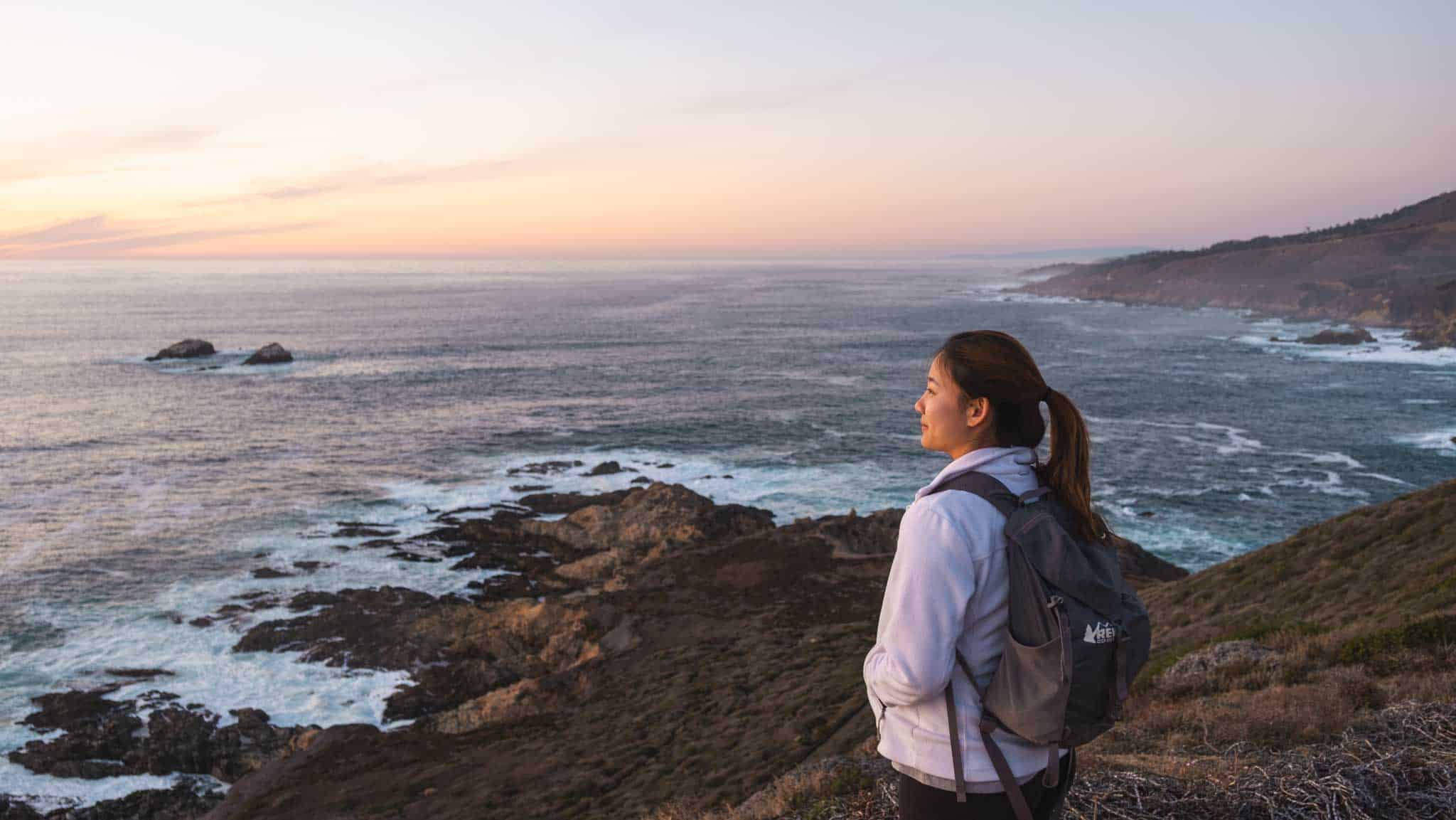
3. Backpacking to a natural hot spring ♨️
For a more adventurous experience, consider backpacking to Sykes Hot Springs. Located in the Ventana Wilderness, this 20-mile round-trip hike takes you through lush forests and along the Big Sur River.
The natural hot springs provide a relaxing reward after the challenging hike, and can be crowded outside the winter season. The trails might be muddy and the river’s water level could be higher if you go after a period of heavy rain. Remember to check trail conditions before you go so you know what to expect.
4. Photograph the sunset through Pfeiffer Beach’s Keyhole Arch 📸
Pfeiffer Beach is famous for its unique purple sand and the stunning Keyhole Arch rock formation. During the winter, the setting sun aligns perfectly with the arch, creating a dramatic and rare photo opportunity.
Arrive early to find a good spot to set up your tripod alongside other photography enthusiasts. When the tide is low enough for the Keyhole Arch to reveal the setting sun, it creates dramatic golden rays against the waves.
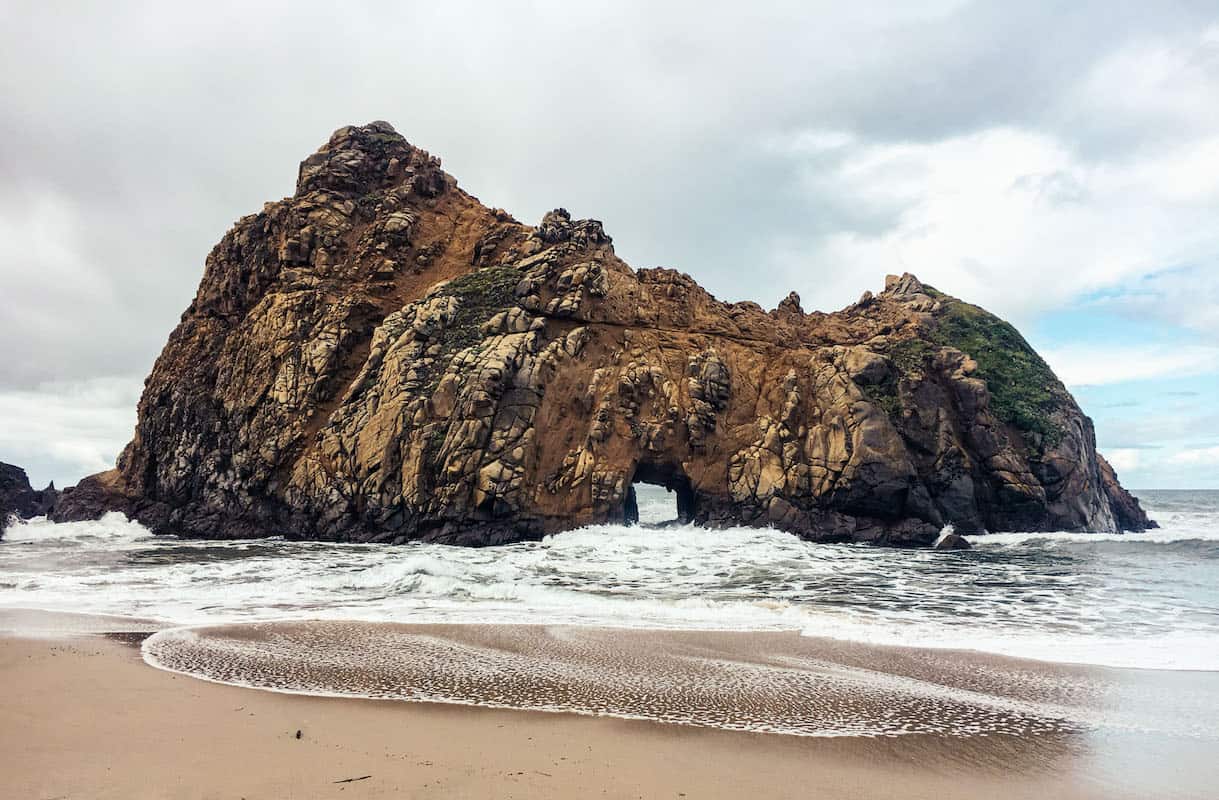
5. Observe the King Tides 🌊
Around the winter solstice, the sun and moon align to create strong gravitational forces that cause king tides and minus tides. King tides can raise tides 1-2 feet higher than usual (even more during a storm), while minus tides expose rocks and reefs that are usually underwater.
The winter king tides often coincide with spectacular coastal conditions, such as increasing the area of the beach that you can walk to. Just make sure to know when low tide is and leave before the tide comes back up.
6. Go camping 🏕
Winter camping in Big Sur doesn’t get too cold unlike on the mountains. Hence it’s perfect for beginners who are trying out cold weather camping. Campgrounds are less crowded and easier to book, and the cooler weather makes for comfortable camping conditions.
Popular places to camp in Big Sur include Ventana Campground, Pfeiffer Big Sur State Park, Andrew Molera State Park, Julia Pfeiffer Burns State Park, and Kirk Creek campgrounds. Alternatively, you can enjoy more amenities at private campgrounds such as Big Sur Campground and Cabins and Ventana.
Do also be prepared for wet conditions and bring appropriate gear to stay warm and dry. It’s possible that the rain causes some difficulty when starting a campfire, so having more fire starters would be helpful.
7. Explore beaches with purple sand 🏖️
Pfeiffer Beach is renowned for its unique purple sand, caused by manganese garnet particles washing down from the surrounding hillsides. The vibrant color is more visible after rain, making winter an ideal time to visit. Another place to look out for this is at Andrew Molera Beach.
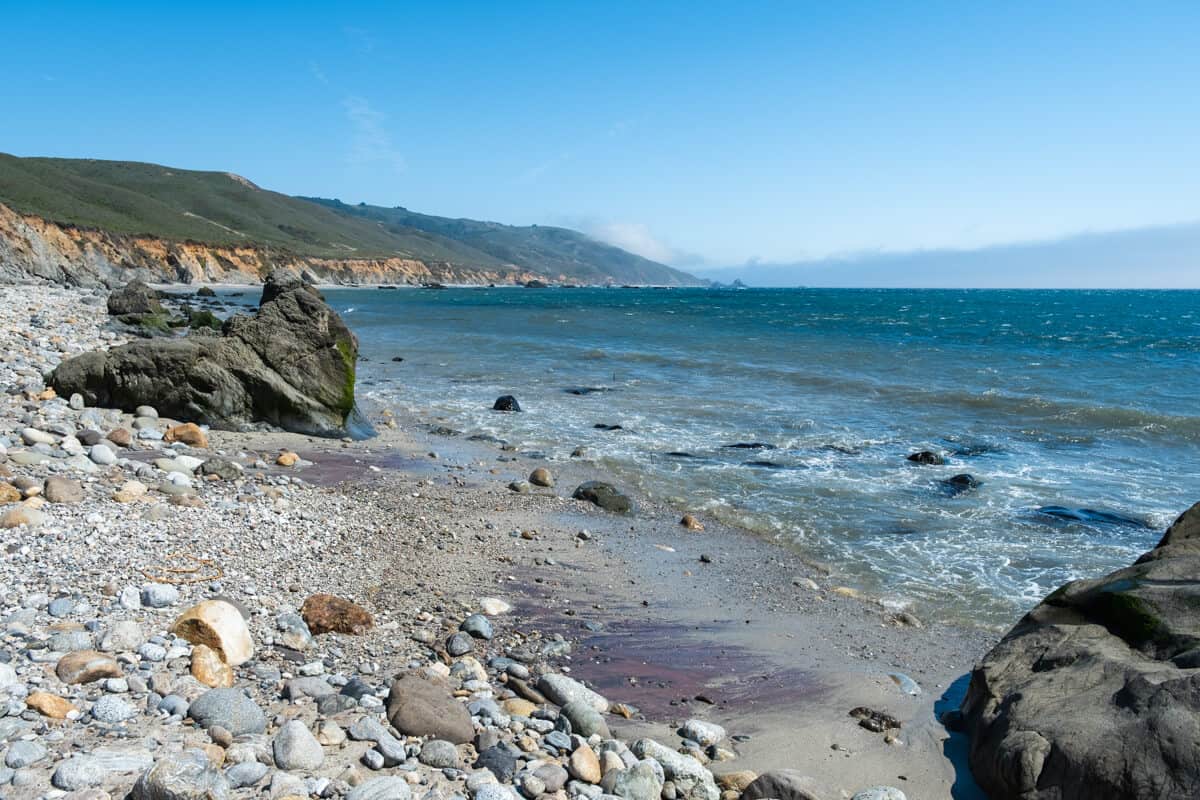
8. Look for overwintering Monarch butterflies 🌲
Monarch butterflies migrate to California’s coast for the winter, seeking refuge in eucalyptus groves. You can find these beautiful butterflies at Andrew Molera State Park. The sight of thousands of monarchs clustered together in the cooler parts of the day is really cool. When it gets warm, you can find them flying around.
9. Visit the Henry Miller Memorial Library 📚
The Henry Miller Memorial Library is a cultural hub dedicated to the famous writer. The library has books for sale, a tree displaying “banned” books, quotes, and more. The peaceful setting amid the redwoods makes it a relaxing spot to immerse yourself in during winter.
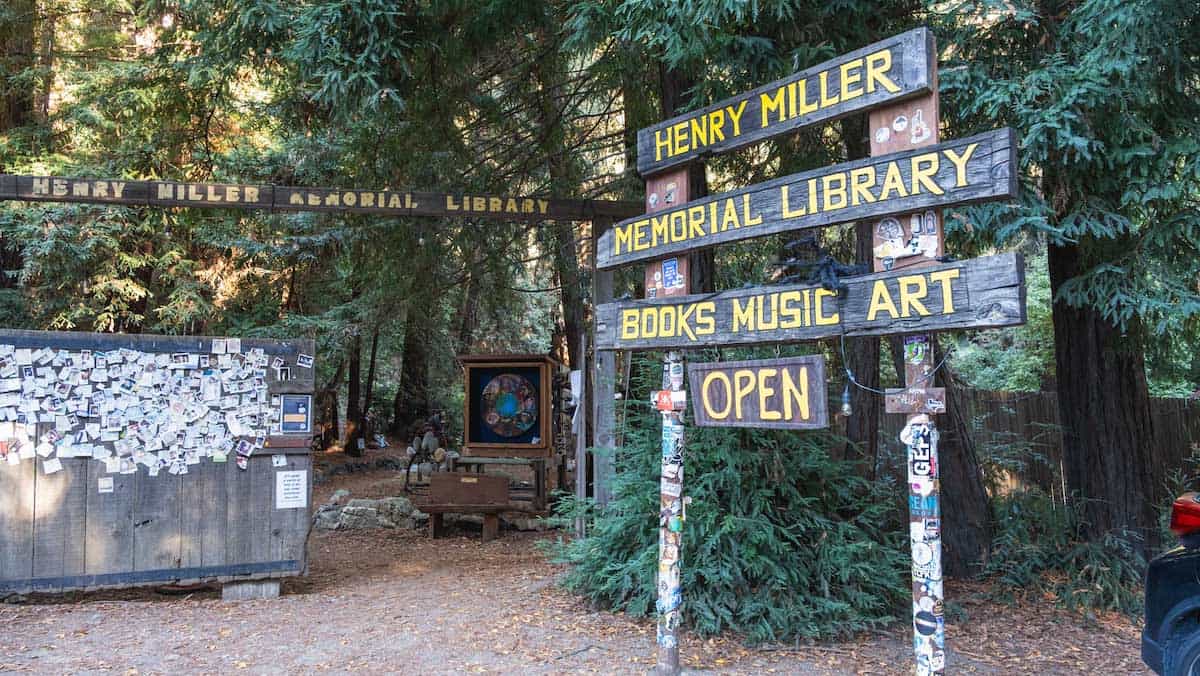
10. Enjoy the Big Sur River💧
The Big Sur River offers opportunities for fishing, wading, and picnicking along its banks. The winter rains cause the river to be fuller, creating a more lush and beautiful landscape.
During winter, some hikes may require you to cross the river (if it’s manageable) making it an even more interesting experience. You could also consider dining at Big Sur River Inn and sitting on the Adirondack chairs that are placed right on the river.
Where to stay and eat
Big Sur offers a range of accommodations to suit different budgets and preferences. Winter is the perfect time to take advantage of off-peak hotel and resort discounts. It could be a great way to celebrate the holidays too.
Budget: Ventana Campground
Ventana Campground provides a rustic camping experience with access to hiking trails and beautiful scenery. The campground offers basic amenities, including restrooms and picnic tables. Camping in winter can be a peaceful experience, with fewer visitors and a closer connection to nature.
Scenic Mid-Range: Big Sur River Inn
The Big Sur River Inn offers charming rooms with scenic views of the river and surrounding forest. The inn’s restaurant serves delicious meals, including hearty breakfasts and comfort food. The outdoor seating area by the river is perfect for relaxing and enjoying the serene environment.
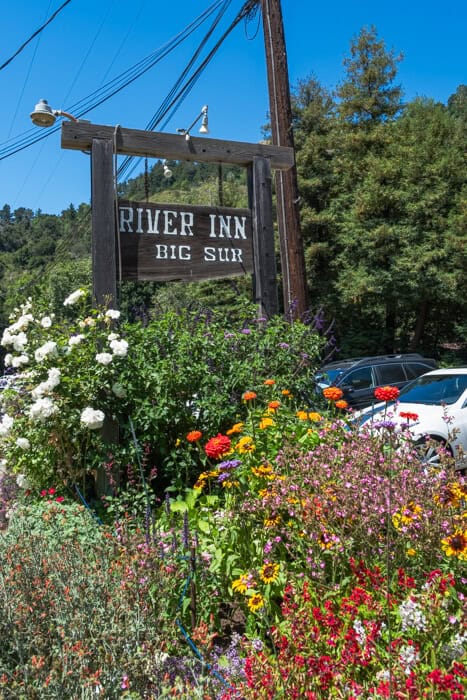
Luxury: Post Ranch Inn
For a luxurious and unforgettable stay, consider the Post Ranch Inn. This upscale resort offers stunning ocean views, infinity pools, and world-class dining. The serene environment and top-notch amenities make it an ideal retreat for a romantic getaway or special occasion.
🏠 Click to browse more winter stays at discounted prices! 🌊
Dining Options
Big Sur General Store: A convenient spot to pick up snacks, picnic supplies, and local goods.
Restaurant at Big Sur River Inn: Enjoy delicious meals in a cozy setting with views of the river.
Deetjen’s Big Sur Inn Restaurant: A charming and historic restaurant offering hearty breakfasts and gourmet dinners.
Sur House: Located at Ventana Big Sur, Sur House offers farm-to-table cuisine with breathtaking ocean views.
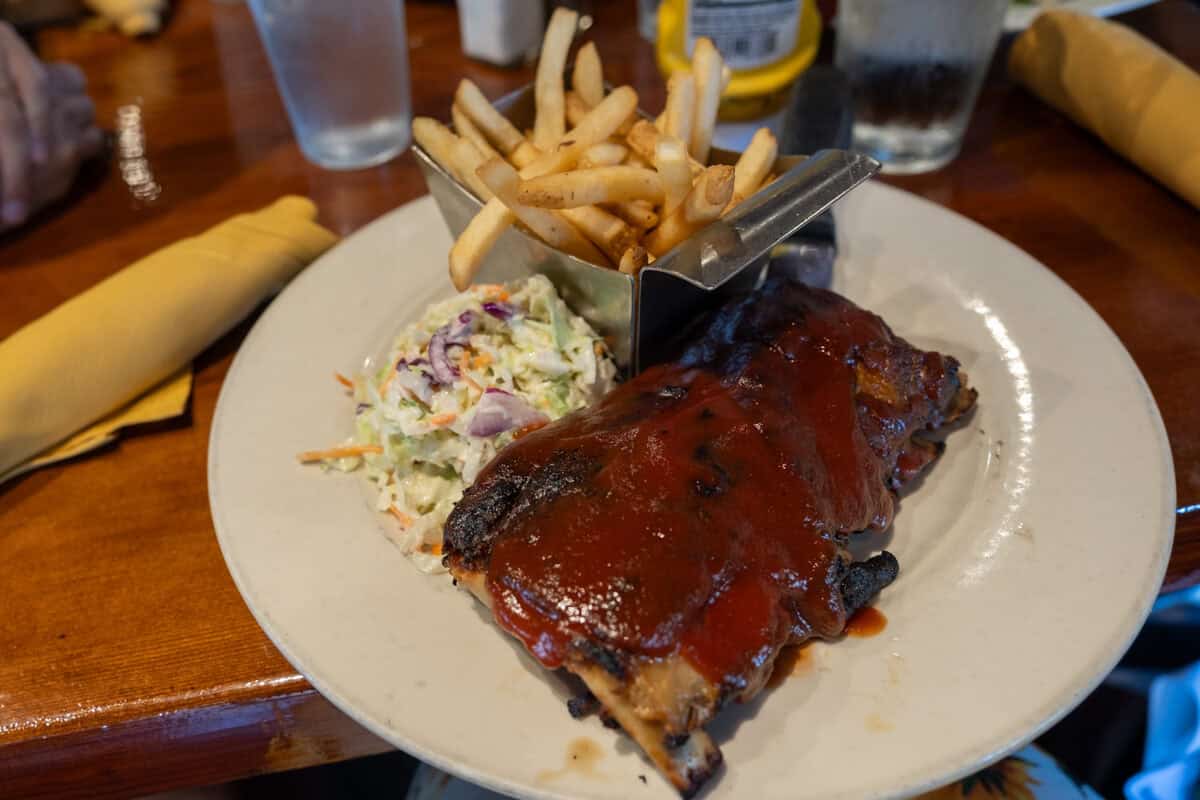
Things to Bring
Packing the right gear is essential for a successful winter trip to Big Sur. Here are some recommendations:
Rain Jacket: A waterproof jacket to keep you dry during rain showers.
Water Shoes or Gum Boots: For wading in the river and exploring tide pools.
Water and a Backup Filter: Stay hydrated with plenty of water and a filter for refilling on the go.
Emergency Bivvy: A lightweight emergency shelter for unexpected situations.
First Aid Kit: Be prepared for minor injuries with a well-stocked first aid kit.
Flashlight or Torch: Essential for navigating in the dark and for safety during night hikes.
Moisture-Wicking Base Layer: Stay warm and dry with moisture-wicking clothing.
Insulated Mid-Layer: An insulated jacket or fleece for added warmth.
Camera and Sturdy Tripod: Capture the beauty of Big Sur with your camera and a stable tripod.
Swimsuit: For a dip in the hot springs or a quick swim in the river.
Gear for Hiking, Backpacking, or Camping: Bring appropriate gear for your planned activities.
Portable Jumpstart Kit: Avoid getting stranded in winter conditions with a jumpstart kit.
How to Get There – Winter Highway 1 Driving
Driving along Highway 1 in winter can be challenging due to rain and potential road closures. It’s essential to stay informed about current road conditions and make alternative plans in case of unexpected closures.
Alternative routes
If Highway 1 is still closed in the central coast, consider using inland routes such as Highway 101 to continue your California road trip.
The location of the road closure and the places you want to visit should help you decide if you want to start your Big Sur trip from LAX or SFO. If I had to choose, since many of the key attractions are in the northern part of Big Sur, I’d start from SFO.
Aside from accessing Big Sur, you can also explore the neighbouring towns like Monterey and Carmel-by-the-Sea. Here’s a 3-day Pacific Coast Highway itinerary to see these coastal towns. Although it may add to your travel time, they are fun alternatives to Big Sur during adverse weather conditions.

Conclusion – What are your Big Sur winter plans?
Big Sur can be worth visiting in the winter for a number of reasons, including fewer crowds, affordable lodging, and unique opportunities to see wildlife. The winter weather, with its rain and cooler temperatures, can enhance the natural beauty of the region, making it a magical time to explore.
As long as you prepare accordingly and stay flexible your plans, you’ll have a memorable adventure in this stunning coastal paradise. I think it’s a lovely destination for a weekend getaway from SF!

